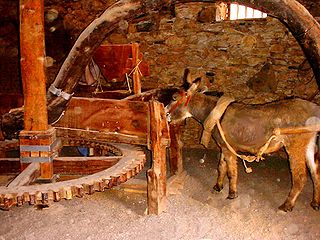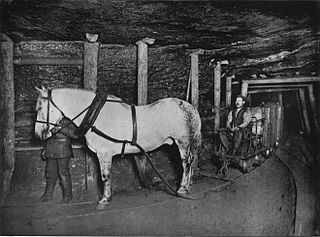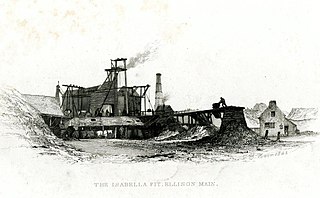Related Research Articles

Sacriston is a village and civil parish in County Durham, England, situated 3 miles (4.8 km) north of the city of Durham.
Brandon is a village in County Durham, England. It is situated a short distance to the southwest of Durham. Brandon was originally one of the seven townships within the ancient parish of Brancepeth. It grew from a sparsely populated agricultural area into a populous mining district after the establishment of collieries and later coke and fireclay works. Until the 19th century Brandon village, formerly known as East Brandon, was one of the larger settlements in Brancepeth Parish.

A horse mill is a mill, sometimes used in conjunction with a watermill or windmill, that uses a horse engine as the power source. Any milling process can be powered in this way, but the most frequent use of animal power in horse mills was for grinding grain and pumping water. Other animal engines for powering mills are powered by dogs, donkeys, oxen or camels. Treadwheels are engines powered by humans.
The Miners' Federation of Great Britain (MFGB) was established after a meeting of local mining trade unions in Newport, Wales in 1888. The federation was formed to represent and co-ordinate the affairs of local and regional miners' unions in England, Scotland and Wales whose associations remained largely autonomous. At its peak, the federation represented nearly one million workers. It was reorganised into the National Union of Mineworkers in 1945.

Caphouse Colliery, originally known as Overton Colliery, was a coal mine in Overton, near Wakefield, West Yorkshire, England. It was situated on the Denby Grange estate owned by the Lister Kaye family, and was worked from the 18th century until 1985. It reopened as the Yorkshire Mining Museum in 1988, and is now the National Coal Mining Museum for England.

A pit pony, otherwise known as a mining horse, was a horse, pony or mule commonly used underground in mines from the mid-18th until the mid-20th century. The term "pony" was sometimes broadly applied to any equine working underground.

Eckley Miners' Village in eastern Pennsylvania is an anthracite coal mining patch town located in Foster Township, Pennsylvania. Since 1970, Eckley has been owned and operated as a museum by the Pennsylvania Historical and Museum Commission.
The Elsecar Collieries were the coal mines sunk in and around Elsecar, a small village to the south of Barnsley in what is now South Yorkshire, but was traditionally in the West Riding of Yorkshire.
The South Yorkshire Coalfield is so named from its position within Yorkshire. It covers most of South Yorkshire, West Yorkshire and a small part of North Yorkshire. The exposed coalfield outcrops in the Pennine foothills and dips under Permian rocks in the east. Its most famous coal seam is the Barnsley Bed. Coal has been mined from shallow seams and outcrops since medieval times and possibly earlier.
The South Waratah Colliery was a coal mine located at Charlestown, in New South Wales Australia.

Coal mining in the United Kingdom dates back to Roman times and occurred in many different parts of the country. Britain's coalfields are associated with Northumberland and Durham, North and South Wales, Yorkshire, the Scottish Central Belt, Lancashire, Cumbria, the East and West Midlands and Kent. After 1972, coal mining quickly collapsed and had practically disappeared by the 21st century. The consumption of coal – mostly for electricity – fell from 157 million tonnes in 1970 to 18 million tonnes in 2016, of which 77% was imported from Colombia, Russia, and the United States. Employment in coal mines fell from a peak of 1,191,000 in 1920 to 695,000 in 1956, 247,000 in 1976, 44,000 in 1993, and to 2,000 in 2015.

The Lancashire Coalfield in North West England was an important British coalfield. Its coal seams were formed from the vegetation of tropical swampy forests in the Carboniferous period over 300 million years ago.
The Astley and Tyldesley Collieries Company formed in 1900 owned coal mines on the Lancashire Coalfield south of the railway in Astley and Tyldesley, then in the historic county of Lancashire, England. The company became part of Manchester Collieries in 1929 and some of its collieries were nationalised in 1947.
Bedford Colliery, also known as Wood End Pit, was a coal mine on the Manchester Coalfield in Bedford, Leigh, Lancashire, England. The colliery was owned by John Speakman, who started sinking two shafts on land at Wood End Farm in the northeast part of Bedford, south of the London and North Western Railway's Tyldesley Loopline in about 1874. Speakman's father owned Priestners, Bankfield, and Broadoak collieries in Westleigh. Bedford Colliery remained in the possession of the Speakman family until it was amalgamated with Manchester Collieries in 1929.
Fletcher, Burrows and Company was a coal mining company that owned collieries and cotton mills in Atherton, Greater Manchester, England. Gibfield, Howe Bridge and Chanters collieries exploited the coal mines (seams) of the middle coal measures in the Manchester Coalfield. The Fletchers built company housing at Hindsford and a model village at Howe Bridge which included pithead baths and a social club for its workers. The company became part of Manchester Collieries in 1929. The collieries were nationalised in 1947 becoming part of the National Coal Board.
Gin Pit was a coal mine operating on the Lancashire Coalfield from the 1840s in Tyldesley, Greater Manchester then in the historic county of Lancashire, England. It exploited the Middle Coal Measures of the Manchester Coalfield and was situated to the south of the Tyldesley Loopline.

Sheriff Hill Colliery or Ellison Main Colliery was a coal mine at Gateshead Fell in County Durham, England. The colliery had two shafts and provided employment to the residents of Sheriff Hill, after it opened in 1793. There were many major accidents resulting in the deaths of workers at the colliery. There was a protracted strike at the colliery in 1834. The colliery closed in 1926.

Bradford Colliery was a coal mine in Bradford, Manchester, England. Although part of the Manchester Coalfield, the seams of the Bradford Coalfield correspond more closely to those of the Oldham Coalfield. The Bradford Coalfield is crossed by a number of fault lines, principally the Bradford Fault, which was reactivated by mining activity in the mid-1960s.
Coal mining played an important part in the history of the Black Country area immediately west of Birmingham, England. It was the basis for the area's industrial development in the nineteenth century; without coal there was insufficient power. Commentators spoke of the Black Country as a great coalfield, and of the earth turned inside out by all the mining activity. Most of the mines were not large scale, but small rough and ready pits similar to the Racecourse Colliery exhibit at the Black Country Living Museum. There were as many as five or six hundred small pits like this exploiting the seams of the South Staffordshire coalfield.
A colliery viewer or coal viewer was the manager of a coal mine or colliery. The term was mostly used in the late eighteenth to nineteenth centuries, in the UK. In modern use, the viewer would be the senior and responsible mining engineer at a site.
References
- ↑ Thomas Southcliffe Ashton, Joseph Sykes The Coal Industry of the Eighteenth Century 1929 p.248 "Land-sale coal was free of tax, and so the regions about the coalfields were given advantages over and above those conferred upon them by nature. London was specially burdened, for the duties there were higher than at most other ports."
- ↑ J. U. Nef The Rise of the British Coal Industry 1136235361 2013 p.184 "It is probable that the miners ordinarily worked fewer days in the coal fields where colliery enterprise was most advanced, and where their daily or weekly wages were normally highest, than in the backward mining districts, where coal was produced for local “ land-sale ”.
- ↑ J. U. Nef The Rise of the British Coal Industry 1136235361 2013 p.184 The conditions of work in the Wear valley and in south Durham, which permitted miners to migrate from the “ land-sale ” to the “ sea-sale " pits during that part of the year when the former were usually idle, could not have prevailed in many other regions."
- ↑ Decisions of the Court of King's Bench 1793 "a "land sale colliery" being a term well known in the coal countries as comprehending not the mine only, but the stock of horses, gins, ropes, and other things necessary for working,"
- ↑ Reports of Cases Argued and Determined in the Court of the King's Bench John Leycester Adolphus, Thomas Flower Ellis - 1836 "In Rex v. North Bedburn (b) the lease of a landsale colliery, rented at 25L a year between two, was held to confer a settlement, though counsel objected that the meaning of a landsale colliery was the right to get coals, with the use of the necessary implements."